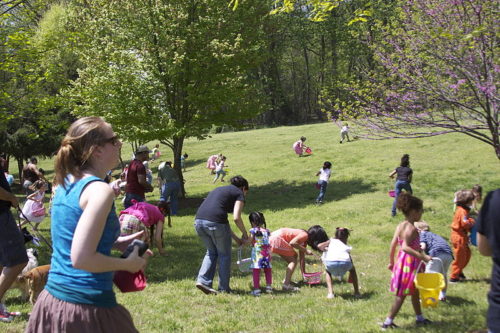
Whether part of Christian Easter celebrations or simply a fun activity, Easter egg hunts have become quite popular in the United Kingdom and North America, as well as in many other countries.
Traditionally, boiled eggs are dyed bright or pastel colours and then hidden for children to find. Today, boiled eggs are often replaced with chocolate or candy eggs or, if the eggs are hidden outdoors, with plastic eggs that may be filled with candy or other treats.
 As well as being a fun activity, Easter egg hunts offer a wonderful opportunity for teaching children about good manners and respect for others. However, with all the excitement and the competitive nature of many Easter egg hunts, they can easily turn into a mad race to get the most with little or no consideration of others. Before you attend an Easter Egg hunt with your children, discuss the activity with them and remind them of the rules of fair play: Pushing and shoving are not allowed; if someone is reaching for an egg, it is already theirs and should not be snatched away; be aware of younger children and don’t knock them over in the rush to find the next egg, help younger children who are having trouble, and so on.
As well as being a fun activity, Easter egg hunts offer a wonderful opportunity for teaching children about good manners and respect for others. However, with all the excitement and the competitive nature of many Easter egg hunts, they can easily turn into a mad race to get the most with little or no consideration of others. Before you attend an Easter Egg hunt with your children, discuss the activity with them and remind them of the rules of fair play: Pushing and shoving are not allowed; if someone is reaching for an egg, it is already theirs and should not be snatched away; be aware of younger children and don’t knock them over in the rush to find the next egg, help younger children who are having trouble, and so on.
If you are planning your own Easter egg hunt, you can control much of the chaos and level of excitement by establishing rules that foster fairness and cooperation rather than sheer competitiveness. Consider the following ideas for creating a cooperative Easter Egg hunt:
- If you are having a small Easter egg hunt, assign each participant a colour or marker and they must find only “their” eggs. If there are too many participants for that level of personalization, have each child return to the start when they have found a set number of eggs, such as five. When all children have found the set number of eggs, they all go out to find five more, and so on until all the eggs are found.
- Set up different areas for children of different ages. Separating areas by the children’s ages allows you to make the event fun and challenging for a wider range of children. For very young children, you will want to place the eggs out where they can be easily seen by the young hunters. For the older groups, you can make the hiding places increasingly difficult to find. Enlist tweens and teens as helpers to hide the eggs or to assist the younger children to find eggs so they can be involved in the fun even though they may feel too old to participate.
- Plan an Easter egg treasure hunt. To encourage cooperation, have groups of children work together to find the eggs in their area or of a specific colour. Be sure to distribute the children evenly by age between the groups and tell them that all members of the team must be included in the process of finding the eggs. When all the eggs are found, the group divides their spoils evenly among all team members. Alternatively, you could hide plastic eggs that contain clues to the next eggs location. When all the clue eggs are found, each member of the team gets their prize, which could be an Easter basket filled with candy and toys, a chocolate bunny, and so on.
Easter egg hunts do not need to be about getting the most at the expense of others. If you teach your children to be considerate of others and to work together, the event will be more fun for everyone.

 Posted in
Posted in  Tags:
Tags: 